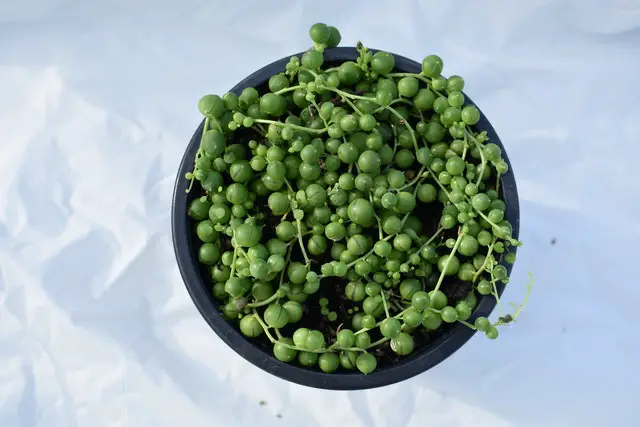String of pearls plants are a popular choice for indoor and outdoor decoration due to their unique appearance. The String of pearls plant is loved for all the good reasons. This plant is a unique green beady, pearl-like plant, also called String of beads.
It is quite a popular gem and is a stunning plant when grown in pots or hanging baskets. Its botanical name is Senecio rowleyanus.
Apart from its engaging leaves, this plant blooms and smells beautiful and is an easy maintenance plant. However, there’s a common misconception about raising this plant.
Although it is a drought-tolerant plant and stores water in its leaves for drought situations, it needs to be watered just as every other plant does. The string of pearls plant is prone to effects of Under watering if its care routines are slurred over for too long.
In this article, we’ll discuss the signs of underwatering and how to revive an underwatered string of pearls, so come along.
Factors to Consider When Watering String of Pearls Plants
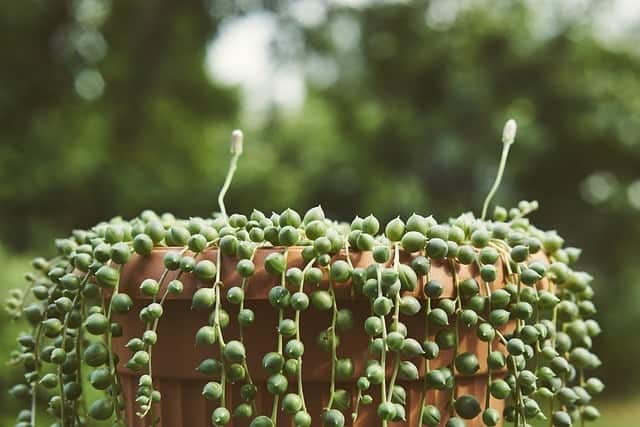
Several factors influence the watering requirements of string of pearls plants. Climate, temperature, humidity, and the size of the plant are some key considerations. During hot and dry seasons, these plants may require more frequent watering, while in cooler months, they need less water.
Another critical factor to consider is the type of potting mix and container drainage. String of pearls plants prefer a well-draining soil mixture that allows excess water to escape. This prevents waterlogged roots and promotes healthy growth.
Additionally, the size of the plant and its stage of growth play a role in watering. Younger plants may have shallower root systems and require less water, while mature plants with well-established roots may need more frequent watering.
The Role of Proper Watering in Plant Health and Growth
Proper watering is essential for maintaining the health and promoting the growth of string of pearls plants. Water plays a vital role in various physiological processes, including nutrient absorption, photosynthesis, and cell turgidity.
Adequate watering ensures that the plant has sufficient moisture to support these processes and transport nutrients throughout its structure. It helps prevent leaf dehydration and ensures the plant maintains its vibrant appearance.
Furthermore, proper watering enhances the resilience of string of pearls plants to environmental stressors. When provided with the right amount of water, they can better withstand temperature fluctuations and periods of drought.
By understanding the watering needs of string of pearls plants and providing them with appropriate moisture, you can promote their health, growth, and longevity. Regular watering, combined with other essential care practices, will help these unique plants thrive in your indoor or outdoor space.
Underwatered String of Pearls
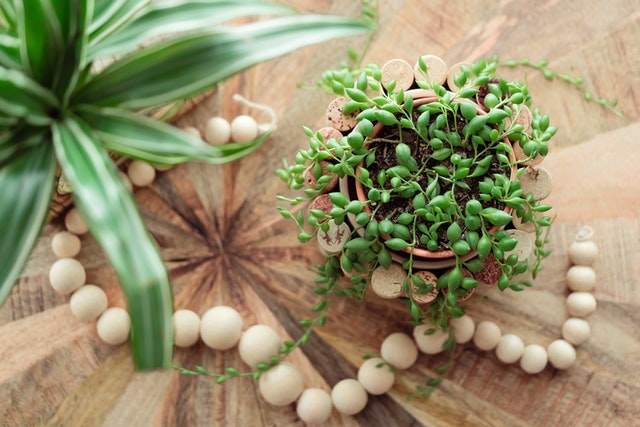
Grown in arid areas of Southwest Africa, the string of pearls plants are believed to be excellent succulent drought-resistant plants, given their leaves’ readiness to drought stress and their immediate natural environment.
However, not so surprisingly, strings of pearls require proper watering culture, as their succulent leaves, which are water-filled, need water to be kept alive. The young plants need more water than the mature plants, so you have to ensure that you’re not neglecting the plant throughout its young and growing stage
Underwatered strings of pearls are often a result of a misunderstanding of their living conditions and thus, irregular watering practices. And leaving them to suffer from this condition may eventually lead to your plant’s death.
Hence, it is essential to pay attention to its watering needs and some important factors to consider while watering it.
If you have started to notice changes in your plants like shriveling and brown leaves, and don’t know why then you should read more on this article. Here are certain signs of underwatering that you should take note of and what you should do when you notice your plants are having effects of underwatering.
1. Shriveling Leaves
This is one of the major signs of an underwatered string of pearls. Dehydrated and drought-stressed plants often shrivel and look like they are dying. When the plant’s water storage runs low, its leaves start to shrivel and dry off.
However, overwatering may also cause shriveling leaves. So the best way to distinguish whether or not the shriveling leaves are due to overwatering or underwatering is by examining your watering culture.
If you have been watering the plant once in one or two months, then your plant is suffering from underwatering. Also, if you water the plant regularly but in little amounts, then you should know the plant is reacting to water shortage or underwatering.
Meanwhile, if your plant has been sitting in a sunny area for a long time, it may be an additional reason for your plant’s dehydration, and will need to be relocated as soon as possible.
However, if you’re certain your plant has been drinking enough water and you still notice your plant shriveling, then you probably are watering more than necessary and you should cut short your water routines, and ensure the top inch of the soil dries out before watering.
Shriveling leaves may eventually lead to your plant’s death so you must take action as soon as your plant starts to give you these signs.
2. Yellowing Leaves
When your plant is under-watered, it may start developing yellow leaves. This is why neglecting your plant’s watering schedules may be dangerous to your plant’s health.
Yellowing leaves will later advance to the leaves dropping off, because of the lack of existent nutrition and moisture in the plant, and will make the plant die in the end.
The best way to deal with yellowing leaves is to remove them from the plant, that is, trim the affected leaves off. This allows the plant to focus on the yet healthy leaves and also prevents the affected plant from infecting other leaves in the plant.
However, this doesn’t entirely solve the problem, as the plant needs to be moisturized to return to its initial healthy condition. Strings of pearls need to be soaked in well in water until water seeps from the drainage holes.
It is best to allow your plant to enjoy as much water as possible.
3. Other Signs
Some other signs of underwatered strings of pearls include thin and small plants and brown and shrunk leaves; the leaves could also have a wilted appearance and will feel soft when touched. The top inch of the soil will also be dry and the roots of the plant will start to die.
Differentiating Underwatering from Overwatering
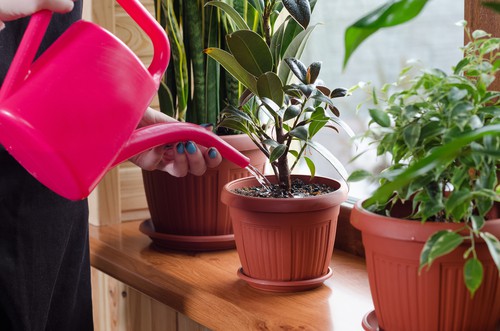
Differentiating between underwatering and overwatering is crucial for providing appropriate care to string of pearls plants. While underwatering occurs due to insufficient watering, overwatering results from excessive moisture in the soil.
The key differences lie in the appearance and feel of the plant and its potting mix. Underwatered plants have shriveled leaves, while overwatered plants may have mushy or discolored leaves. Underwatered soil feels dry and may pull away from the sides of the container, while overwatered soil remains consistently wet and soggy.
To confirm if your string of pearls plant is underwatered, gently press a finger into the soil near the base of the plant. If the soil feels dry several inches down, it is an indication of insufficient watering.
Addressing Underwatering and Providing Adequate Water
To address underwatering in string of pearls plants, it is important to provide them with adequate water and establish a proper watering routine. Start by thoroughly watering the plant until water drains out of the pot’s drainage holes, ensuring the entire root ball is moistened.
Observe the plant’s response and adjust the watering frequency as needed. It’s better to slightly underwater than overwater these plants. Allow the soil to dry out between waterings, but ensure it doesn’t become bone dry.
Additionally, consider the environmental conditions that may contribute to underwatering, such as high temperatures or dry air. Provide indirect sunlight and maintain moderate humidity levels around the plant to help prevent excessive moisture loss.
How to Revive Under Watered Strings of Pearls
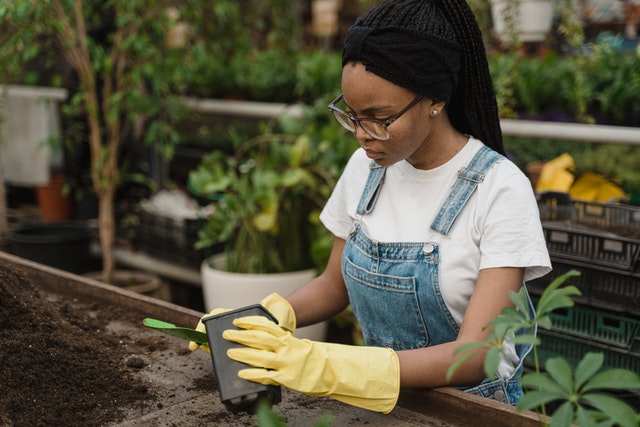
If you have already ascertained that your plants are showing signs of underwatering, then you should immediately treat them and resuscitate the plant.
Here are some guides to follow to revive your under-watered string of pearls.
1. Change Its Location
We have briefly discussed this but it is important to reiterate it. In its natural environment, strings of pearls grow under bushes or rocks, and thus, are protected from intense sunlight. Thus, to make this plant at its best, you will need to replicate its living conditions in its natural environment.
Strings of pearls are best grown in indirect sunlight; exposing your plant to direct sunlight will further dry out the leaves and make them shrivel. To begin reviving your plant, you have to make sure your plant is not getting direct sunlight, because this will be disastrous to the leaves.
Place your plant in a position where it can be provided with bright but indirect sunlight; you can do this by placing it in a shaded area or a few meters away from a window.
Also, remove your plant from any possible heat source, such as a heater, air conditioning units, and radiators, that may dry out the moisture in the plant.
2. Water Frequency
How often should you water your plant? This is an important question, and the watering frequency of your plant is dependent on some factors.
The most important factors for watering are the climate you live in, the time and season of the year, and the soil condition.
If you live in a dry climate area, then you’ll need to adapt your water schedules to the dry environment. Water the plant often, at least once every 7-10 days; however, if you live in a humid area, you may not need to water as much; you can water the plant once every two weeks.
This also applies during the summer and spring; the plant needs to be moisturized during these seasons.
In winter, watering can be reduced to once every two to three weeks.
The last factor to consider is the soil condition of the plant, your plant needs well-draining soil to absorb water and as well, drain water.
The condition of the soil contributes to the moisture of the plant, and in the provision of its essential nutrients. The best soil mix for this plant is an airy porous textured soil, including components like perlite, orchid bark and vermiculite.
You may also get a commercial potting mix from nurseries around you. Another crucial thing to note while watering is the amount of water to use in watering.
Your plant needs to be generously soaked in water every time you water; water the plant until water starts to trickle down the drainage holes, then wait for the soil to dry out before soaking in the water again.
3. Soil Replacement
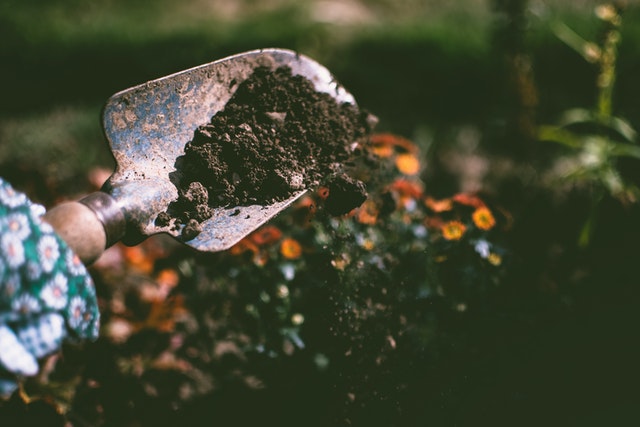
You should only do this if the soil is repelling water. After soaking the plant with water, remove the plant from the pot; this should be relatively easy if the plant is already wet.
Then, start to loosen the soil from the plant gently without causing harm to its roots. Then, replace the soil with fresh well-drained porous succulent soil and replant. This is a valuable step in reviving underwatered strings of pearls.
Read a related post: What Does An Overwatered Aloe Plant Look Like
Outro
The string of pearls plant is a lovely pea-like plant that will absolutely adorn your home and live healthily indoors. Although it is low-maintenance, it should not be ignored, and must be supplied with sufficient care and affection to grow beautifully.
One of the many problems the plant may face is underwatering and if you’ve ever had to face the problem of reviving your underwatered string of pearls, then this article must have given you an insight into treating your plant the right way.
The happiest plants are the ones provided with the necessary growing conditions.
Frequently Asked Questions
Is my string of pearls overwatered or underwatered?
This question is best answered by you. You may only know the cause of your plant’s condition by examining your watering practice. As we earlier stated, if you have been watering your plant irregularly and in small amounts, then your plant is certainly growing through an underwatered phase.
But if you give your plant enough to drink frequently, then you might be doing a little too much.
How can you tell if a pearl string is thirsty?
If your plant has a dull uninteresting look and feels a bit hard to touch, then it is thirsty. And a thirsty plant should be given a good drink.
How often should I water my string of pearls?
Conveniently, once every two weeks. To ensure you’re maintaining a proper schedule, deep a finger in the soil of the plant, if the first 1.5 inches of the soil is dry, then you should water the plant. This will also help you to prevent overwatering.

Hey, I’m Lisa and I’ve been an avid gardener for over 30 years. I love writing, talking and living in the garden! Feel free to connect with me on my socials below

